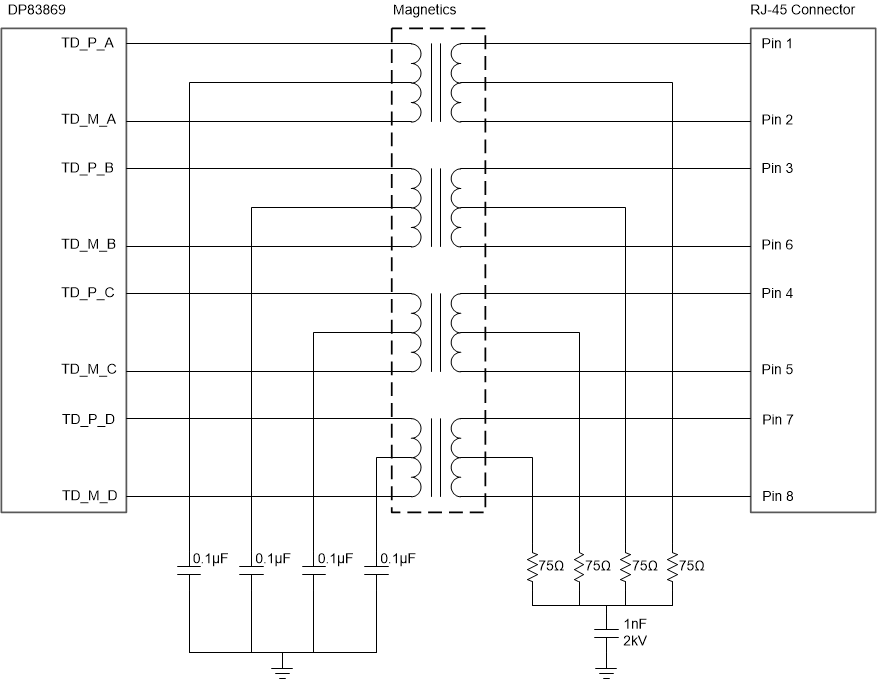SNLA443 December 2023 DP83869HM
- 1
- Abstract
- Trademarks
- 1DP83869 Application Overview
- 2Troubleshooting the Application
- 3Operational Mode Clarification
- 4Tools and References
- 5Summary
- 6References
2.3 Component Checklist
Magnetics:
The following guidelines are the main specifications to reference for compatible magnetics:
Table 2-2 Magnetic Electrical
Specification
| PARAMETER | TEST CONDITIONS | TYP | UNIT |
|---|---|---|---|
| Turns Ratio | ±2% Tolerance | 1:1 | - |
| Insertion Loss | 1-100 MHz | -1 | dB |
| Return Loss | 1-30 MHz | -16 | dB |
| 30-60 MHz | -12 | dB | |
| 60-80 MHz | -10 | dB | |
| Differential to Common Mode Rejection | 1-50 MHz | -30 | dB |
| 60-150 MHz | -20 | dB | |
| Crosstalk | 30 MHz | -35 | dB |
| 60 MHz | -30 | dB | |
| Open Circuit Inductance | 8-mA DC Bias | 350 | μH |
| Isolation | HPOT | 1500 | Vrms |
- Turns Ratio
- Ideally 2% but 3% is tolerable
- Insertion Loss
- As close to 0 dB as possible
- Return Loss
- At or smaller magnitude
than specified in Table 2-2
- If specification gives -16 dB typical, finding a component with -16 dB, -17 dB is recommended.
- At or smaller magnitude
than specified in Table 2-2
 Figure 2-1 PHY to RJ45 and
Magnetics
Figure 2-1 PHY to RJ45 and
Magnetics- Each center tap on the side connected to the PHY must be isolated from one another and connected to ground by a decoupling capacitor (0.1 µF recommended).
- Pulse Electronics part, HX5008FNL is recommended for a discrete magnetics solution.
Crystal or Oscillator
The following guidelines are the main specifications to reference for compatible crystals and oscillators:
Table 2-3 25-MHz Crystal
Specifications
| PARAMETER | TEST CONDITION | MIN | TYP | MAX | UNIT |
|---|---|---|---|---|---|
| Frequency | 25 | MHz | |||
| Frequency Tolerance | Including operational temperature, aging, and other factors | ±100 | ppm | ||
| Load Capacitance | 15 | 40 | pF | ||
| ESR | 50 | ohm |
Table 2-4 25-MHz Oscillator
Specifications
| PARAMETER | TEST CONDITION | MIN | TYP | MAX | UNIT |
|---|---|---|---|---|---|
| Frequency | 25 | MHz | |||
| Frequency Tolerance | Operational temperature, 1 year aging | ±100 | ppm | ||
| Rise and Fall Time | 20% - 80% | 5 | ns | ||
| Symmetry | Duty cycle | 40% | 60% |